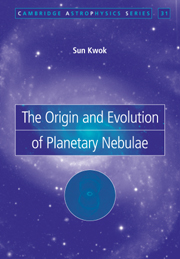Book contents
- Frontmatter
- Contents
- Preface
- 1 History and overview
- 2 Ionization structure of planetary nebulae
- 3 Nebular line radiation
- 4 Nebular continuum radiation
- 5 The neutral gas component
- 6 The dust component
- 7 Observations of the central star of planetary nebulae
- 8 Morphologies of planetary nebulae
- 9 Problems and questions
- 10 Asymptotic giant branch stars – progenitors of planetary nebulae
- 11 Evolution of the central stars
- 12 Formation of planetary nebulae
- 13 Dynamical evolution of planetary nebulae
- 14 Protoplanetary nebulae – the transition objects
- 15 Evolution to the white dwarf stage
- 16 Distances to planetary nebulae
- 17 Comparison between evolutionary models and observations
- 18 PN in the galactic context
- 19 Chemical abundances
- 20 Planetary nebulae in other galaxies
- 21 Concluding remarks
- References
- Appendix List of symbols and abbreviations
- Subject index
1 - History and overview
Published online by Cambridge University Press: 04 November 2009
- Frontmatter
- Contents
- Preface
- 1 History and overview
- 2 Ionization structure of planetary nebulae
- 3 Nebular line radiation
- 4 Nebular continuum radiation
- 5 The neutral gas component
- 6 The dust component
- 7 Observations of the central star of planetary nebulae
- 8 Morphologies of planetary nebulae
- 9 Problems and questions
- 10 Asymptotic giant branch stars – progenitors of planetary nebulae
- 11 Evolution of the central stars
- 12 Formation of planetary nebulae
- 13 Dynamical evolution of planetary nebulae
- 14 Protoplanetary nebulae – the transition objects
- 15 Evolution to the white dwarf stage
- 16 Distances to planetary nebulae
- 17 Comparison between evolutionary models and observations
- 18 PN in the galactic context
- 19 Chemical abundances
- 20 Planetary nebulae in other galaxies
- 21 Concluding remarks
- References
- Appendix List of symbols and abbreviations
- Subject index
Summary
The first planetary nebula was observed by Charles Messier in 1764 and was given the number 27 in his catalog of nebulous objects. The final version of the Messier catalog of 1784 included four planetary nebulae (PN) together with other nonstarlike objects such as galaxies and star clusters. The name planetary nebulae was given by William Herschel, who found that their appearances resembled the greenish disk of a planet. With better telescope resolution, nebulae that are made up of stars (e.g., galaxies) were separated from those made up of gaseous material. PN were further distinguished from other galactic diffuse nebulae by that fact that PN have definite structures and are often associated with a central star. This distinction became even clearer with spectroscopy. The first spectrum of a PN (NGC 6543) was taken by William Huggins on August 29, 1864. The spectra of PN are dominated by emission lines, and not a continuous spectrum as in the case of stars. The first emission line identified was a Balmer line of hydrogen (Hβ), although stronger unidentified lines could be seen in the spectrum. Since the spectra of PN are entirely different from those of stars, their luminosity cannot be due to reflected starlight.
The idea that PN derive their energy from a nearby star was first considered by Herschel (1791). However, no further progress was made for another century.
- Type
- Chapter
- Information
- The Origin and Evolution of Planetary Nebulae , pp. 1 - 8Publisher: Cambridge University PressPrint publication year: 2000

